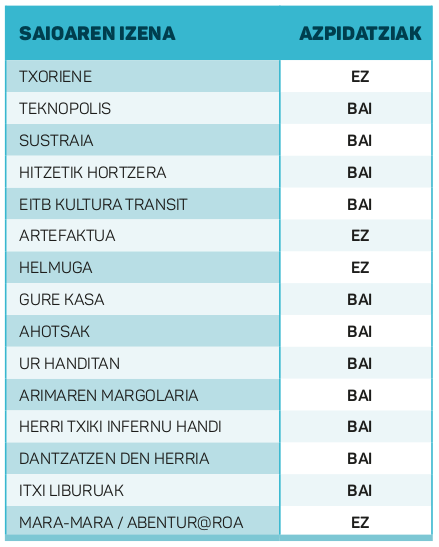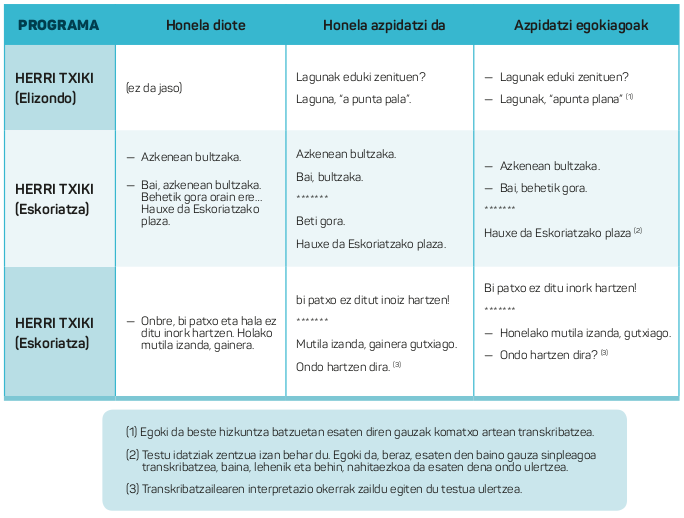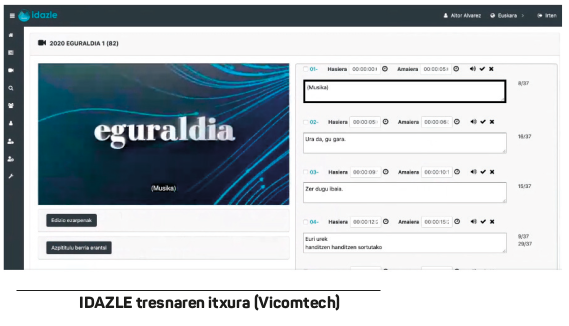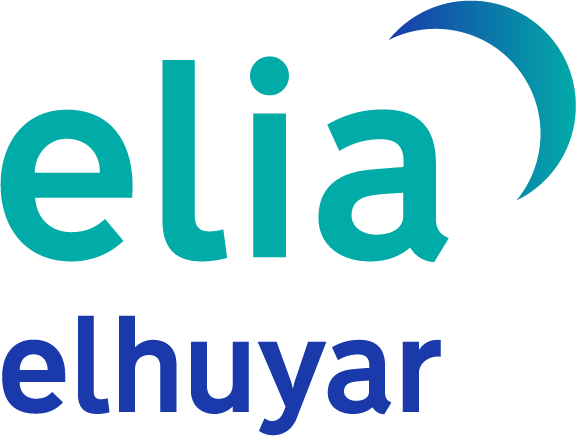ETB will ensure the accessibility of the Basque Country, allowing the understanding of the contents to those who do not understand the Basque Country, for which it would facilitate the offering of subtitles. The same applies to those who have little understanding of the Basque language, since the writing would support the original language. And, of course, to guarantee the right of people with listening problems to access audiovisual media. The written version also serves this purpose. By the way, as long as intelligibility is guaranteed, the Basque would be heard (and would not be hidden as in the case of duplication). We therefore believe that ETB should be used as a tool for technology and accessibility in audiovisual translation, to facilitate access to the minority language without discrimination and on equal opportunities. That is what we will try to demonstrate in this work.
1. Introduction and motivation
Euskal Telebista has approved the recovery of the undersigned, both in the first (ETB 1) and in the second (ETB 2), that is, in Basque and in the first. However, the decision, as we shall see, has not been planned and, consequently, the usefulness of the subtitles is not guaranteed in any way, either for people with hearing problems or for people with difficulty in understanding the language. EiTB has not decided on the characteristics that underwriters should have, at least as it did in its day with the doubles (Barambones, 2005; Zabalondo, 2013) —although in the style book and in the informative book it specifies how underwritings should be (EiTB, 2016: 169). However, in relation to the rest of the programming, and in relation to the offer of subrogations started after the year 2019, EiTB does not follow up either in the reception of the sub-writings or in the supervision of the good state of issue. Even EiTB has asked television programme producers to use technology to create subtitles — the voice recognition text production technology developed by the company Vicomtech — thus becoming the producers" responsibility.
This study aims to demonstrate that, although EiTB"s decision to offer subtitles is appropriate, as it can contribute to making the Basque Country more accessible and allows guaranteeing the right of people with hearing problems to access these contents, this practice should be organized. In other words, the objective and characteristics of the subtitles must be defined in advance (within the parameters used in audiovisual accessibility, and the Basque language adapted to the characteristics of the language). These are, therefore, the hypotheses of this study: on the one hand, the decision to offer subtitles is adequate and can represent a path full of possibilities for the Basque Country, but on the other hand, EiTB has not made any planning to determine for what and how this offer will be developed, so there is no strategy, and that is a missed opportunity. In fact, underwriting is essential in an audiovisual environment and in an area with or without a hegemonic minority language. Furthermore, although much research has been done in the field of audiovisual translation on the use of subtitles and their value, especially in the field of audiovisual translation and audiovisual accessibility to guarantee the rights of people with hearing problems (Luyken, 1991; Ivarsson, 1992; Díaz, Matamala and Neves, 2000; Orero, 2005; Chaume, 2004), the same has not been possible on accessibility.
This work is part of a broader research. In 2015, it started with subtitle measurements to analyze the linguistic offer of ETB and general television in the Spanish state and its compliance with audiovisual accessibility. He gave us the poem to understand accessibility as a guarantee of greater amplitude and access to minority languages. In this period, machine translation has facilitated the creation of automatic subwritings through technology, and Euskal Telebista has also opted for this path. To this end, Vicomtech has started to use the technology developed by the company and offer the producers the possibility to use this technology. For this reason, it has seemed appropriate, in order to advance research, to analyze the sub-sections generated by the producers and, on the other hand, to take into account what other countries are doing and public televisions in audiovisual accessibility.
Thus, for this article, several research techniques are combined: together with a review of the bibliography cited, two interviews have been conducted with the Euskal Telebista programmer, the four most viewed television producers working for EiTB have responded to a questionnaire carried out to this effect, and recordings have been made of television broadcasts —for a week, 24 hours in a row— to see what subtitles have been written and used in
The analysis of all these data allows us to understand the use that Euskal Telebista is making of the subtitles. And the deficiencies detected (problems of synchronization, errors in translation, lack of definition of accessibility standards…) have helped us define the next steps of research. Thus, in the next steps, the study will allow us to determine the suitability of the subtitles of public television in Basque and propose its dissemination.
Likewise, this study allows us to verify the feasibility of the option of subtitles for the incorporation of audiovisual content generated in Basque to the Spanish television channel, so that EiTB as a whole becomes an inclusive environment for the Basque country.
2. Sectoral situation and objectives
ETB writing was created by a single channel in Basque. At that time, the Basque knowledge among the population aged between 16 and 65 years was 24.07% in Araba, Bizkaia and Gipuzkoa, 33.09% in Iparralde and 9.55% in Navarra (Eustat, 2011). In this situation, and in order to ensure that the audiovisual content offered in Basque reaches as many people as possible, the Basque Government decided to use the interlinguistic sub-writings: what was heard in Basque was subtitled in Spanish. As established by Law 10/1982 on the normalization of the use of the Basque Country, "All citizens are recognized as having the right to be informed by the social media, both in Basque and Spanish. To this end, the Government will take measures to increase the presence of Euskera in the media, so that the use of both official languages is progressively compensated” (Article 22). The last part of this commitment will be of vital importance for the decisions made later by Euskal Telebista. And Law 5/1982, of the creation of the Euskal-Radio Television Public Entity (Section 3, h), gathered "The promotion of culture and of the Basque Country, for the purposes of the use of the Basque Country, through the establishment of basic and articulated programs, taking into account the need to balance Basque radio and television broadcasts at the level of global supply in the Autonomous Community". However, the legal text did not determine how this balance would be maintained. Therefore, and as has already been said, the television programs that were made in Euskera or folded in Euskera were written in Spanish (Barambones, 2011), both to comply with the law and to promote the Euskera, "because the subtitles would help those who had a low Euskera level" (Etxebarria, 1994: 193).
This practice lasted between 3 and 4 years, until a second channel in Spanish was incorporated into ETB, which was created as an instrument to guarantee the normalization of the Basque Country. Consequently, the translation into Spanish was no longer necessary and disappeared from the Basque channel (Larrinaga, 2019). This decision drastically disrupted the development that audiovisual subwritings could have in our environment and excluded people with hearing problems from public service. And as could not be otherwise, they benefited from the assistance of subtitles for the learning of the Basque country (Larrinaga, 2000). It should not be forgotten that the Basque Country is situated in the area of dubbing, together with the Spanish and French States, Italy, Germany or Austria (Gambier and Sumoel-salmi, 1994) and in the Spanish State, as in the French State, there is the habit of consuming double hegemonic international cinema (Spanish and French). This has happened with the film produced in Basque in Spanish cinemas and also in our own, where, on the pretext that the distributors are more public, it has frequently opted for dubbing to the detriment of the original subtitled version (Chaume 2004: 53). This tradition, in its attempt to compete on equal opportunities, accentuates the invisibility of minority languages in favor of the doubles made in Spanish. In the same vein, even when television fiction has been offered in Spanish, it has been doubled, regardless of the original language. Following this tradition, ETB 2 continues not to broadcast its own fiction (series) — either duplicate or sub-written — offered in ETB 1. Both channels are turning their backs on this, which may be an obstacle to Basque public television being inclusive. In other words, ETB 1 has functioned exclusively for all Vasco-speakers, giving them partially to one side to the Euskaldunes, and ETB 2 has barely made room for Euskera, a co-official language.
Like other countries with minority or non-hegemonic languages, the Spanish State has developed its own rules and laws on audiovisual consumption and broadcasting. Reference is often made to the treatment of minority languages on public television, some of which are controlled through the European Charter of Regional or Minority Languages (Perez and Deogracias, 2021). However, these activities to ensure the visibility of the minority language do not seek to be accessible to people with hearing, vision or those who do not know the language. In other words, part of the hearing is not taken into account. And the possibility of audience growth is excluded, guaranteeing access to such content. This becomes more evident in these times of the expansion of digital platforms, where more and more audiences consume content from all languages around the world using subtitles (Agirre, 2021). In fact, as the consumption of these platforms has spread, the generation of subtitles has been increasing, as well as to enable the consumption of audiovisual in minority languages. Therefore, we want to raise audiovisual accessibility, already recognised as a right, as a profile accessibility (UNCRPD, 2014)3. Thus, "the interpretation of accessibility as a proactive principle for the achievement of human rights also helps to avoid the effect of ghetto" (Greco, 2016: 11). And not only because it helps people with disabilities and the elderly participate in social and cultural life by offering them accessible audiovisual services, but also as market rights. Not to promote exclusions. I mean, to avoid audience ghettos. Not only does the Audiovisual Directive of the European Union recognise that the right of people with disabilities and the elderly to participate and integrate into the social and cultural life of the community is inevitably linked to the provision of available audiovisual services. The means to achieve accessibility, such as language, subtitles, audio description and easy-to-understand menu navigation, should be the same” (AVMSD, 2018). Because it opens up the possibility to minority languages. Because it is beneficial that the minority language is not limited to its users and extends beyond, contributing to linguistic, cultural and multilingual diversity. It would also serve as accessible audiovisual content as a meeting point for the majority and minority languages. In this sense, ‘it is to be assumed that the benefits of accessibility, as well as the languages of minorities through subtitles, contribute to the learning of the language (…), and the transfer of the language is a key place in the development of the European audiovisual sector – where cultural and linguistic diversity come together’ (Andersen, 1995: 4).
One might think that one should focus on the dissemination of Basque content in the Spanish media and also take steps to bring non-Basque citizenship closer to Basque content through the Basque media (Narbaiza, 2016: 363-364). In this context, the path taken by Galesa public television S4C, aligned with the objective of his government, is significant: ‘S4C plays a key role in promoting and developing the Welsh language to support the Welsh Government’s goal of having a million Welsh rapporteurs by 2050’ (Papagiannouli and Davies, 2018: 11). Thus, the planning it has adopted to achieve this objective has agreed, among others, to support the Welsh creative industries and to improve relations with minority language producers, especially Celtic producers, to share information and best practices and to seek opportunities for collaboration (idem, 2018: 11). In this sense, the number of hours subtitled has increased, both in Welsh and English: “S4C programs are more attractive with English subtitles. Underwriting is suitable for non-Welsh speakers, have a mixed language in the home and have hearing problems. English subtitles are available in 80% of the S4C programs” (SC 44). And in the approved document it says that "Wales"s publishing service is aimed at both Welsh pupils and the Welsh public with hearing problems, students and those who do not trust to talk about Welsh, to enjoy the S4C programmes. Underwriting is available in Welsh in 7-8 hour S4C programs” (SC 45). Because "it is not the same to underwrite audio-visual produced in hegemonic languages (VOS, original sub-written versions) that underwrite productions produced in minority languages in other languages. In the first case, the viewer listens to the hegemonic language and reads the diminished. In the second case it happens the other way round: you hear the minority language and you have to read the sub-written language in the other language (usually the hegemonic language)” (Zabalondo, Deogracias and Azpilwaukee, 2020: 211).
New technologies now allow optional subtitles or offer audio channels of folded content in different languages. We believe it is essential that the content in Basque goes beyond the rights of a linguistic community to the whole of Basque citizenship (Narbaiza, 2016: 364).
3. Basis and conclusions of the investigation
As mentioned at the beginning, ETB has recovered the underwriting, 30 years later, on both emission channels. Thus, “thinking about the public who may have difficulty accessing Basque broadcasts, ETB offers Basque subtitles” (Larrinaga, 2019: 262). But these subwritings are not offered in all sessions and on a regular basis, nor are they worked. In fact, ETB began its experimental underwriting in 2019 and does not yet advertise the subtitle offer anywhere. To view the subtitles, the subtitles are activated in television broadcast by remote control. The subsections are also offered on the web à la carte, the digital portal of EiTB, where they are also free to activate. It should be noted that some fiction content offers bilingual sub-writings, such as the television series Hondar Ahoak (Txintxua Films, 2020), in which the producer has produced subtitles in Basque and Spanish. In the ETB 1 issue, subtitles were offered in Basque.
The decision of ETB to offer the underwriting has been marked by advances in translation technologies. In 2019, for example, ETB 1 offered 18% of the total emissions of the chain in Euskera, and 46% in the Spanish-language chain, according to data provided by ETB. These percentages of ETB 1 coincide with those obtained in recordings performed in the framework of our study, while those of ETB 2 show a clear upward trend. The follow-up conducted between 21 and 27 February 2020 (24 hours, 7 days) shows that ETB 1 underwrote 17% of its programming in that period, while ETB 2 did 61.23%. It should be noted that most of the sub-titled programs were recurring and recorded previously, so 12 of the 16 television programs added the subtitles in the 2019 ETB 1 broadcasts. Euskal Telebista only offers live subtitles in the news. They are created by another external company from scripts and following the accessibility standards for accessible subwritings provided by AENOR (UNE 153010:2003). The other programming does not take account of the rule on audiovisual accessibility.

Although quantitatively the presence of sub-sections has increased, and despite the effort to comply with the Audiovisual Law 2010 with the provisions of Regulation X, the national and regional televisions that broadcast openly from 2013 subwrite 75% of their contents for people with disabilities (Law 7/2010: 19)—, there is a notable lack of inspection, which is still experimental and does not follow any technical, linguistic or even cultural criteria. When Euskal Telebista was created, the underwritten “thought of the citizens who did not have the necessary Basque level” (Larrinaga, 2019: 184) if any, strategies or plans have not been identified in the decision to subwrite. Moreover, the creation of subtitles has been assigned to the producers who perform programs for Euskal Telebista, and although almost all of them are using the tool of WRITER developed by Vicomtech, ETB has not received any rules or clarifications on their characteristics at any time. Consequently, the sub-sections are composed according to the criteria of the person in charge of the subtitles in each producer, and these people are not experts in the sub-sections or in the translation, as indicated by the questionnaire they answered: Some of the answers included in the questionnaire were ‘We are not experts in language’, ‘In the absence of suitability advice: characteristics of the sub-sections’ or ‘Receive an assessment of the sub-headings, define the criteria, know if we are well’.
Currently, the quality of the producers" underwriting is not seen on television. As an example, a single producer surveyed has reported having received criteria related to Euskera from the Basque service of ETB (see Table 2). Given that the Herri Txiki Infernu Handi program interviewed citizens who speak Basque in the dialect, they were advised how to receive a series of statements about it, to conform to the unified Basque criteria, but also to correct the interpretations of the transcriptor (see note 3 in Table 2).

To perform this work, the producers use the tool WRITER created by the technological center Vicomtech6. This tool, through voice recognition, automatically generates the transcripts and the responsibility to review and cure these texts is the responsibility of each producer. As explained by those responsible for the WRITER instrument, the system needs one third of the duration of the television program to convert what is heard into text, that is, to create subtitles. According to the data obtained in the survey among the producers, to subwrite a 1-hour session it takes 4-5 hours (in principle 10-12 hours).

AUTHOR (Vicomtech)
As you can see in the figure above, an editing system allows you to edit automatically created texts, make any modifications you want and adjust the synchronization. However, synchronization problems have been detected in the emissions of the sessions under inspection, making it difficult for the viewer to maintain the sessions correctly.
4. Forward-looking guidance
It is expected that, as the tool improves, synchronization problems will decrease. But we also believe that it is up to ETB to monitor the content it receives prior to the issue and to define its language policy taking into account accessibility. Beyond linguistic correctness, the commitment to subtitles in Basque should be strategic both for people with hearing problems and to support the Basque learning process. We therefore insist on the need to revise the subparagraphs and, before that, to define clear criteria for their characteristics.
We also believe that in addition to the intrallinguistics sub-writings, the interlinguistic sub-redactions should be feasible, that is, that in ETB 2 inter-linguistic sub-writings are used to give visibility to the Basque (audio in Basque and subtitles in Spanish). As mentioned at the beginning, this would help in two directions: enabling people who do not understand the Basque language to enjoy the contents of the Basque language and enabling the Basque language to be heard, even people who do not know the language. Moreover, why refuse to reach more audience with fictitious content produced in Basque? It should not be forgotten that 55.2% of those over the age of 16 are neither vasco-speakers nor vasco-speakers (Socio-linguistic Survey, 2016) and that sub-writings can be an excellent opportunity to reach that large audience.
Finally, the law on audiovisual accessibility and linguistic rights should go hand in hand in defining an appropriate language policy, especially if we take into account the transformation that audiovisual consumption is undergoing, in which digital platforms are becoming increasingly important. ‘As a result of the new environment, if no action is taken, there is a risk that audiovisual public services will be excluded or limited to becoming mere television services’ (EBU, 2002), or so on, in ghettos (Greco, 2016).
Thus, we consider that the hypotheses stated at the starting point of this study have been corroborated: The decision to offer ETB subtitles is correct, as well as for the normalization of Euskera, but Euskal Telebista does not currently have a subtitle strategy. Cooperation between the audiovisual sector, the language academy and public television should therefore be encouraged to define and define the characteristics of the subtitles, also taking into account associations of people with hearing problems. In this way, the Basque language is guaranteed to be an inclusive Basque television guaranteeing the characteristics, understanding and accessibility of the language.
Bibliography
Andersen L. (1995): “The Translation of Film Titles”. Sequentia, 2(4):4.
Agirre, K. (2021):“Minority languages and the streaming revolution: the case of Basque cinema on Netflix”, Communication&Society. [in press].
AVMSD (2018): Directive 2018/1808 of the European Parliament and of the Council of 14 November 2018. <https://eur-lex. europa.eu/eli/dir/2018/1808/oj> <https://eur-lex. europa.eu/eli/dir/2018/1808/oj> <https://eur-lex. ▪ .eu/eli/dir/2018/1808/oj>
Barambones, J. (2005): “History of audiovisual translation in Basque: Adequacy and duplication of ETB Memory 1”. Senez, 28, 77-94.
Barambones, J. (2011): “A telescopic look at Basque cinema: original, folded and subtitled versions”. Airtight. Translation and Interpretation No. 13, 1-22.
EBU (2002): Media with a Purpose. Public Service Broadcasting in the digital era. The Report of the Digital Strategy Group of the EBU.
Chaume, F. (2004): Cinema and translations. Madrid: Can.
Deogracias, M. and Amezaga, J. (2016): “Linguistic Accessibility for Small Language Cinema.” International Journal of Sociotechnology and Knowledge Development (IJSKD), 8(2), 16-26. Doi:10.4018/IJSKD.2016040102.
Diaz Ribbons, J. Matamala, A. & Neves, J. (2010): New insights into audiovisual translation and media accessibility: Media for all 2. Rodopi. Leiden, The Netherlands: Brill.
Government of Spain (2010): Law 7/2010, of 31 March, General of Audiovisual Communication, BOE, 79, of 1 April 2010, Madrid.
Etxebarria, I. (1994): “Dubbing and subtitling in the Basque Country”, in F. Eguiluz, R. Merino, V. Olsett and E. Pajares (ed. ), cultural transfers: literature, cinema and translation. Vitoria-Gasteiz: University of the Basque Country, 1994, 191-197.
Basque Government, Government of Navarra and Public Entity of the Basque Country (2016): VI.- Sociolinguistic Survey, Donostia. <https://www.euskadi.eus/contenidos/informacion/ikerketa_soziolinguistikoak/eu_def/adjuntos/VI_INK_SOZLG_EAE_Aurkezpen_publikoa_20161014.pdf> <https://www.euskadi.eus/contents/information/ikerketa_soziolinguistikoak/eu_def/attachments/VI_INK_SOZLG_EAE_Aurkezpen_publikoa_20161014.pdf> <https:
Eustat (2018): Population aged 16 and over in the Basque Country with linguistic profile by territory and age. 1991-2016. Basque Government. Department of Culture and Linguistic Policy. Sociolinguistic Survey<https://eu.eust.eus/elements/ele0009500/euskal-herri-16-urte-oa-β- <https://eu.eust.eus/elementos/ele0009500/euskal-herri-16-urte-oa-β-▪ - - -efecto-territorial-yedad-seg-edad/tbl0009564_e.html> - -effect-territori-yedad-seg-age/tbl0009564_e.html>
Basque Government (1982): LAW 5/1982, of 20 May, of the creation of the Public Entity “Euskal-Radio Televisión”. BOPV 71. Vitoria-Gasteiz.
Gambier, Y. Suomela-Salmi, E. (1994): “Subtitling: A type of transfer”, in: Eguiluz, F., Merino, R., Olsen, V, Pajares, E., Santamaría, J.M. (ed) Cultural transfers: literature, cinema, translation. Vitoria-Gasteiz: Universidad del País Vasco, 1994, 243-252.
El Greco, Gian Maria. (2016): “On Accessibility as a Human Right, with an Application to Media Accessibility”, Matamala, A. and Orero, P. (Ed. ), Research Audio Description. New Approaches. Barcelona, 11-33, exp. 10.1057/ 1-137-56917-2_2.
Ivarsson, J. (1992): Subtitling for the Media: A Handbook of an Art. Transedit, Simrishamn.
Larrinaga Larrazabal, A. (2019): “Creation, development and function of Basque Television in the context of the normalization of the Basque Country”, doctoral thesis. UPV/EHU
Larrinaga Larrazabal, A. (2000): Sub-securitisation in ETB-1. Proceedings of Mercator Conference on Audiovisual Translation and Minority Languages. Mercator.
Luyken, G. (1991): Overcoming Language Barriers in Television: Dubbing and Subtitling for the European Audience. The European Institute for the Media, Düsseldorf.
Narbaiza Amillategi, B. (2015): “Communication models, Basque language and television”, doctoral thesis. UPV/EHU
Orero, P. (2005): Inclusion of accessibility in audiovisual communication within audiovisual translation studies. - Revista de Traducció, (12), 173-185.
Papagiannouli & Davies (2018): “The Future of Welsh-language broadcaster S4C: Funding and Remit” <https://blogs.lse.ac.uk/medialse/2018/04/18/the-future-of-welsh-language-broadcaster-s4c-funding-and-remit/> <https://motel.lse.ac.uk/medialse/2018/04/18/the-future-of-welsh-language-broadwords-s4c-aid-and-remit/>
Pérez, M.; Deogracias, M. (2021): “Barriers and opportunities for cinema distribution in European minority languages. The case of O que arde in the Digital Single Market”, Language & Communication 76, p. 154-162, Parchment, exp. :10.1016/J.LANGCOM.2020.11.006.
Sabarís Martin, Rosa M. Cantalapiedra, M. Zalbidea, B., and EiTB (2016): EiTB style book: information and news. Bilbao. ISBN \940427-6-8
S4C, Acces Services (2020): Retrieved April 20 2020,<http://www.s4c.cymru/en/access <http://www.s4c.cymru/en/access -services/page/5857/welsh-subtitles/> -services/page/5857/welsh-subtitles/>
Zabalondo, B. Deogracias, M.; Azpilwaukee, P. (2020): “EUVOS. Immaterial European Cultural Heritage. Towards a programme of subtitling in European non-hegemonic languages”, SENEZ, 51, 207-220. ISSN 1132-2152.
Zabalondo Loidi, B. (2013): Audiovisual translation in Basque: professional dubbing”, UZTARO 85, 73-96, exactly: 10.26876/July-85.2013.4
Acknowledgements and observations
I should like to thank Josu Amezaga Albizu, the director of my thesis project.
This work was prepared for the IkerGazte International Congress 2021 Ikerketa Euskaraz in June 2021.
This work has been funded by the Department of Education, Linguistic Policy and Culture of the Basque Government (IT-881-16) and is part of the work we are doing jointly in the research project ALMA Network of Excellence on R+D+i for accessibility and minority languages in audiovisual media (ED-2018-102475-T).
1.- According to data from EiTB, in 2019 18% of the contents of ETB 1 were underwritten, in ETB 2 46%, in ETB 3 58% and in ETB 4 18%.
2.- LAW 5/1982, of 20 May, of the creation of the Public Entity “Euskal-Radio Televisión”.
3. The protocol on the rights of persons with disabilities was adopted at the United Nations in 2006 (A/RES/61/106).
4.- Full explanations are available at https://www.s4c.cymru/en/access -services/page/5854/english-subtitles/
5.- Details at https://www.s4c.cymru/en/access -services/page/5857/welsh-subtitles/
6.- EiTB is a member of the board of Vicomtech. The project was created at the end of 2000 by the INI and EiTB Foundation <https://www.vicomtech.org/es/vicomtech/▪ -interna> <https://www.vicomtech.org/es/vicomtech/ internal>.


